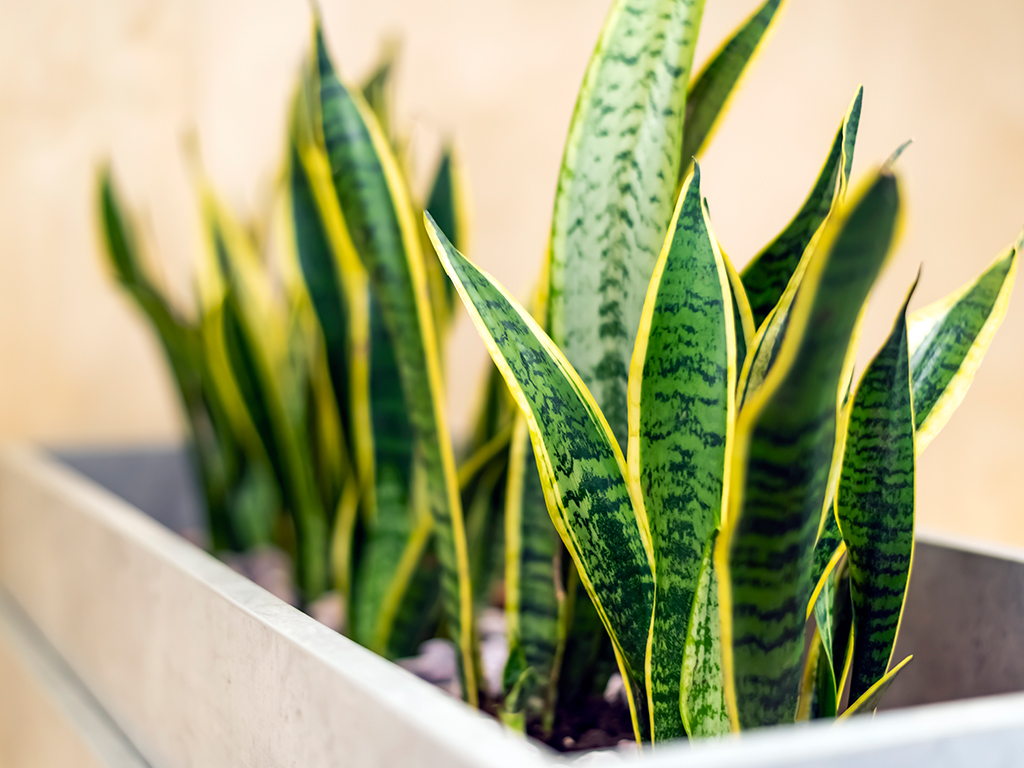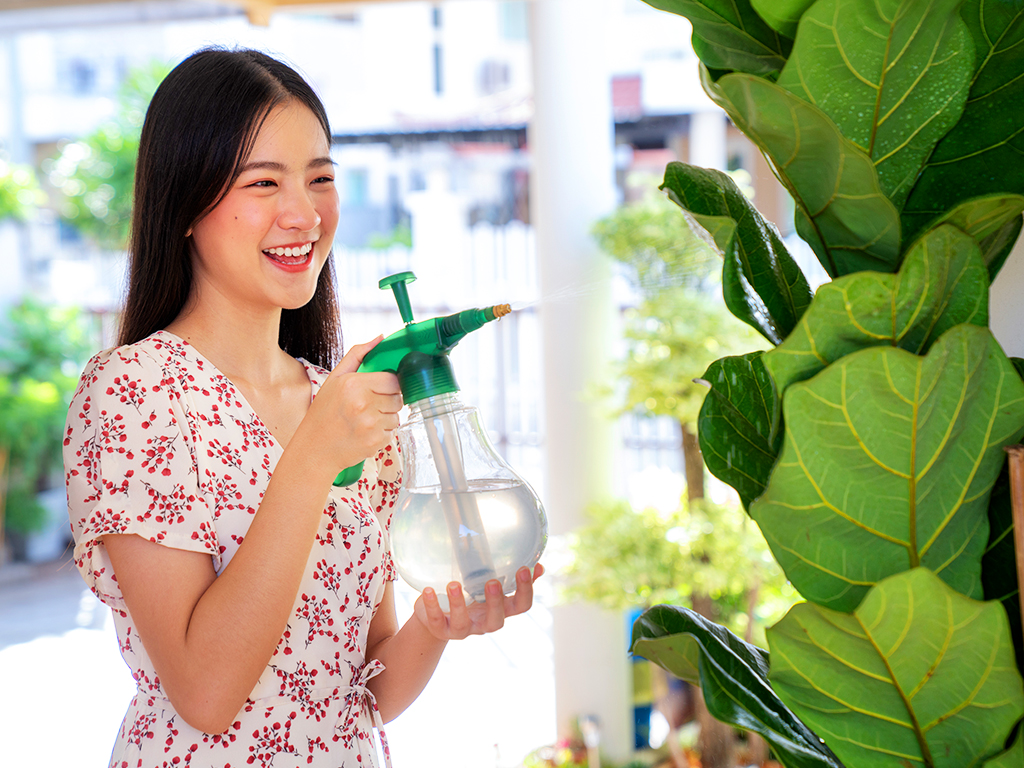Which cleans the air better: houseplants or air purifiers? We’ll spare you the suspense; if air cleaning was a race, air purifiers would win every time.
“What!?” you cry, nearly dropping a drip-tray of succulents. “But the nice clerk at the nursery gave me a list of the best air purifying plants. It was laminated and everything.”
Most of us—even the most avid city dwellers—save a place in our hearts for the beauty of tamed nature. For this reason, we really want to believe our indoor gardening improves not only our mental health, but the air as well. Unfortunately, that just isn’t the case—at least, not in any significant way.
We’ll discuss the belief that plants clean indoor air—both how it got started, and why it is misleading. We’ll also explain what plants do well, and why air purifiers still do it better.
“But I Read It on the Internet!”
“Okay Mr. Smarty-Pants,” you reply as you water a pot of mother-in-law’s tongue. “If that’s true, why do hundreds of blog articles propound the best plants for purifying the air? Why is there a TED talk on it? Why do people sell air purifiers with plants in them?”
Unfortunately, nearly this entire movement started with a single 1989 study whose results, while technically accurate, have been terribly misrepresented.
In 1989, NASA scientist Dr. B.C. Wolverton was theorizing about an energy efficient way to prevent the buildup of air pollution on shuttles, space stations, and “future space habitats.” He and his team performed an interesting series of experiments using some common houseplants. He enclosed these plants into small chambers and injected either benzene, trichloroethylene, or formaldehyde into the chambers; the team measured how quickly and thoroughly the plants filtered out these volatile organic compounds. Wolverton’s team also compared the air filtration rate of these plants to empty chambers without plants (for a baseline), and to chambers with just potting soil (in case the microbes in the soil were the real heroes).
There were some interesting (but hardly extraordinary) results to this experiment. For instance, Gerber Daisies were able to remove 67.7% of benzene in 24 hours. However, while the plants did help remove airborne VOCs more quickly, that doesn’t mean they were actually quick. The peace lily was the best at removing trichloroethylene, but it only managed 23% in 24 hours. For such a dangerous VOC, this really isn’t much help.
Then, the team tried something new. They put an activated carbon bed beneath the potting soil and used a fan to pump air through it. Their hope was that the activated carbon would catch the VOC, and then the plant would break the VOC down into harmless byproducts. This method was indeed successful, (as well as economical). It filtered the air effectively within 2 hours. For this reason, the study recommends that “activated carbon filters containing fans[...]should be an integral part of any plan using houseplants for solving indoor air pollution problems.”
Here’s where things went wrong: the activated carbon got the results, but the plants got all the press. "Plants remove over 90% of pollutants from the air" makes a better headline than "A well-vetted method of air purification removes certain extremely specific toxins from the air of a sealed chamber; (oh, and—by the way—a plant may have helped a little too)."
 Pictured: Three snake plants trying their best to filter the air.
Photo Credit: Yuliya Koshchiy / Getty
Pictured: Three snake plants trying their best to filter the air.
Photo Credit: Yuliya Koshchiy / Getty
Of CADR and Chrysanthemums
“So how effective are houseplants by themselves?” you ask while scooching a snake plant out of direct sunlight.
Unfortunately, they aren’t. Recently, a 2020 Drexel University paper reanalyzed 12 studies in which plants supposedly purified the air. They found that once they converted the results to a metric CADR rating, the plant’s ability to clean the air in your home all but disappeared. (As a reminder, CADR stands for Clean Air Delivery Rate.)
Every single houseplant reviewed by the paper had a CADR rating of significantly less than 1 cubic meter per hour. For comparison, the CADR rating of an average air purifier is 100 cubic meters per hour!
According to National Geographic, these results mean you’d need 10 plants for every single square foot of space to have even a hope of impacting the environment in a significant way. Even if you were able to do this (which would mean either a) building a living wall or b) leaving no space to walk), your home or business would gain pest and humidity problems along with its minorly improved air quality.
What About Other Contaminants?
“Well, okay, plants don’t remove VOCs, but what about other types of indoor air pollution?” you ask while fondly pruning your ponytail palm. “Surely plants purify ozone, at least?”
Not according to Dr. Elliot Gall of Portland State University; he reported to the Atlantic that you would need 1 plant every 20 square feet to even make the slightest impact on ozone levels. Admittedly, that is fewer plants than are needed to make an impact on VOCs, but it is still quite a lot for most people.
We all learned by fifth grade that plants remove carbon dioxide and increase oxygen. They must at least provide this benefit to your home, right? While this is technically true, the amount of oxygen any given houseplant adds is insignificant. According to GardenMyths.com, a plant “would need to increase in weight by 3.75 Kg (8 pounds), each day, to produce the oxygen used by one person.” Unless you are Seymour from Little Shop of Horrors, you probably don’t have a plant which grows this quickly. We speculate that one plant, duckweed, might come close, but you’d need a very large aquarium; it only grows in water.
Plants do a little better with indoor particulate matter. According to one Beijing study, “If a leaf has significant microstructure, such as a rough surface, pubescence and a grooved ridge protuberance, mucus oils and short petioles, it can retain large numbers of particles.” Another study shows plants can even absorb and ingest particulate matter if it is small enough.
However, Dr. Gall reminds readers (in the aforementioned Atlantic article) to compare the surface area of a houseplant with the surface of everything else in a home or office. In other words, plants might be efficient at catching particulates per square centimeter, but your undusted bookcase is probably catching far more total.
 Pictured: A pothos that wants so much to help with air quality. Photo Credit: Grumpy Cow Studios / Getty
Pictured: A pothos that wants so much to help with air quality. Photo Credit: Grumpy Cow Studios / Getty
The Curious Case of Tree Walls
“I can’t believe this,” you cry, clutching a single precious golden pothos to your chest. “I won’t believe it. You just want to sell me air purifiers. Plants have to do something!”
Well, of course, we want to sell you air purifiers, silly; we’re an air purification company. But that doesn’t make any of this untrue.
However, in the interest of objectivity, we will point out there are indeed plants which can significantly improve natural air quality; the only catch is, they aren’t indoor plants.
Several studies have determined that outdoor trees and shrubs do collect a significant amount of particulate matter. According to the previously cited National Geographic article a tree wall around buildings may significantly increase indoor air quality, presumably by preventing particulates from infiltrating the building via air exchange.
As the aforementioned study of various plant species in Beijing puts it, “The presence of plants increases the roughness of the earth’s surface, resulting in lower wind speeds and allowing atmospheric PM to be deposited more easily[...]As such, planting both trees and shrubs may efficiently reduce PM both near the ground and higher in the canopy.”
Not all particulate matter resting on leaves is gone for good though. Admittedly, oils and waxes from the plant do cause a certain percentage to stick permanently, and other captured particulate matter may be washed by rain into the ground. However, the study also cites that “up to 50% of deposited particles may become resuspended.”
Even though trees and shrubs help, the returns are limited. A British study found that increasing the coverage of trees in one region “from 3.7% to 16.5% [would reduce] average primary PM10 concentrations by 10% from 2.3 to 2.1 μg[/]m−3 removing 110 tons per year of primary PM10 from the atmosphere.” Certainly, 110 tons of particulate matter removed from the air sounds impressive. However, notice the small percentage decrease in particulate matter vs. the large requisite increase in tree coverage. The study further estimates that planting trees in every available space would only reduce PM10 by 26%. That’s a lot, but clearly, we need to do better than that indoors.
“So, What Can I Do?”
“I get it now,” you cry, ordering bamboo palms in bulk on back order. “I’ll just grow an indoor jungle for that 26% reduction in particulates. Perfect!”
Let’s pause for a moment and consider: 26% is a best-case scenario. Outdoor parks and tree walls are very different from shrubs in the foyer. Indoors, there isn’t any wind to blow particulate matter across plants' leaves or rain to wash it into the ground. Your removal rate indoors would likely be far less.
Which would you rather do: install a jungle for minimal returns or install a single air cleaner for a 99.97% reduction in particulate matter? After all, true HEPA filters remove 99.97% of particulates that pass through.
As for VOCs, ActivePure Technology can reduce those quite nicely (along with reducing mold and pathogens). A laboratory tested our tech on 4 common VOCs. After the test, formaldehyde was the same as average outdoor air levels. Toluene was found to be much lower than outdoor levels. Meanwhile, acetaldehyde and benzaldehyde weren’t detected at all. (Source: “Fighting Viral Spread with Air Purification Technology” by Avisha NessAiver, Medstartr Direct.) If ActivePure alone produces such results, can you imagine what we do when paired with an activated carbon filter and HEPA? In fact, we do just that in many of our machines for a triple boost of protection.
After you install an ActivePure unit with HEPA and carbon filters, you can still grow that indoor jungle if you want; (and we admit, it does sound pretty cool). When it comes to crediting the resulting air quality though, don’t kid yourself. The purifier will be doing most of the work.
 The joy plants provide should not be determined by their usefulness. Photo Credit: NeoPhoto / Getty
The joy plants provide should not be determined by their usefulness. Photo Credit: NeoPhoto / Getty
What Plants Really Do
“Aha!” you say. “I knew you wanted me to kiss my spider plant goodbye and replace it with a soulless air purifier!”
Firstly, our air purifiers are not soulless but exquisitely designed, thank you very much. And secondly, just because houseplants don’t effectively remove toxins doesn’t mean they don’t have any benefit at all. Plants are wonderful; (the author has a peace lily and a pothos sitting nearby as he writes this). It’s merely important to be realistic about what actually makes them wonderful.
What makes houseplants wonderful is…(drum roll)...they are pretty.
Yep, that’s it. Beauty should be enough of a reason to keep your Boston Fern around. Don’t make it work for its supper (or rather, its water) too. After all, you don’t expect your pointillist wall painting or tasteful end table to clean the air. Let plants be plants and air purifiers be air purifiers. You’ll take greater joy in both because of it.
“Now I get it! I’ll contact ActivePure today to get an air purifier.” You pause mid-repotting to wipe your hands, glancing fondly at the flowers just beginning to bud. “...and I’ll take the pressure off my petunias.”



